实例介绍
【实例截图】

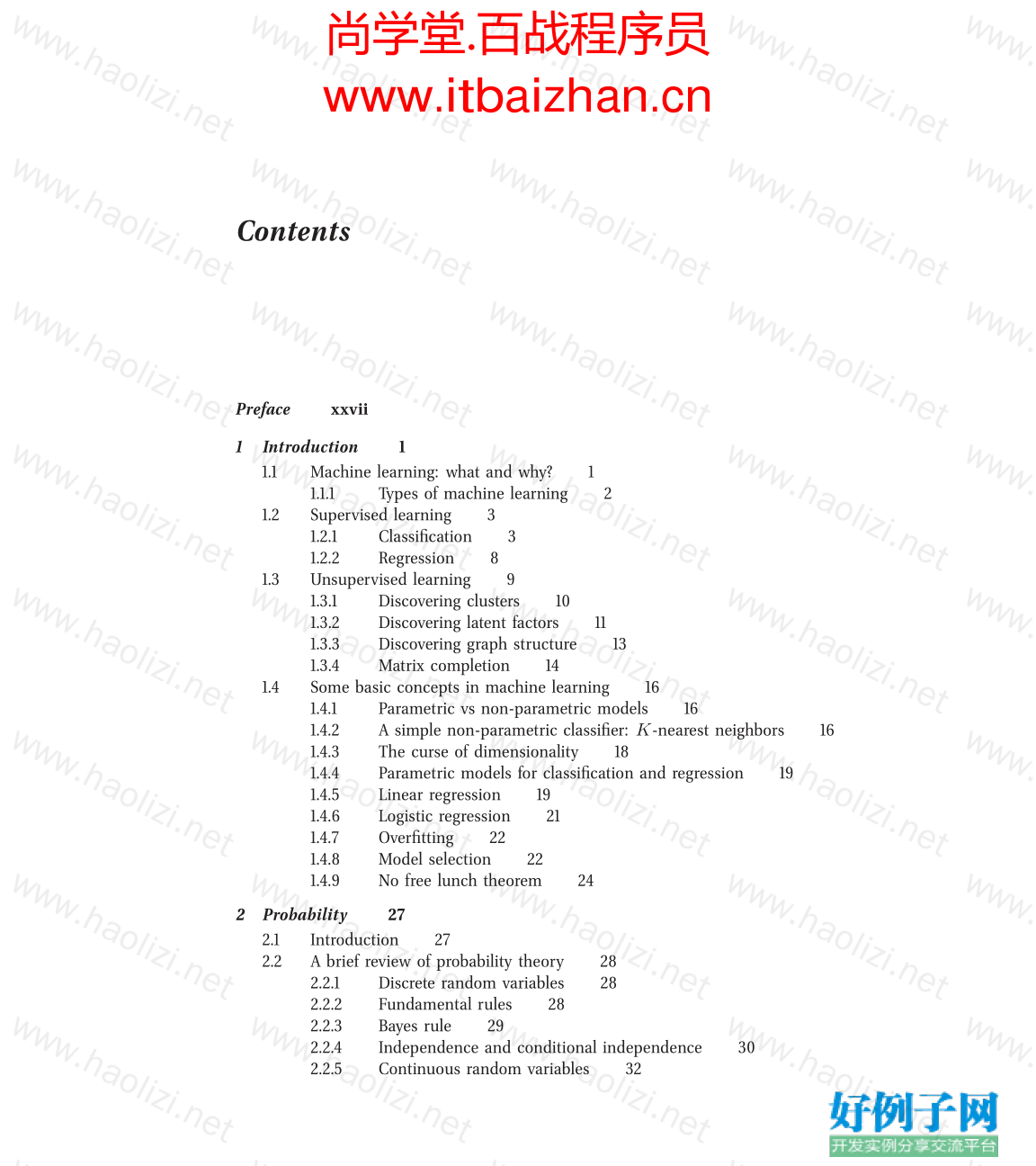
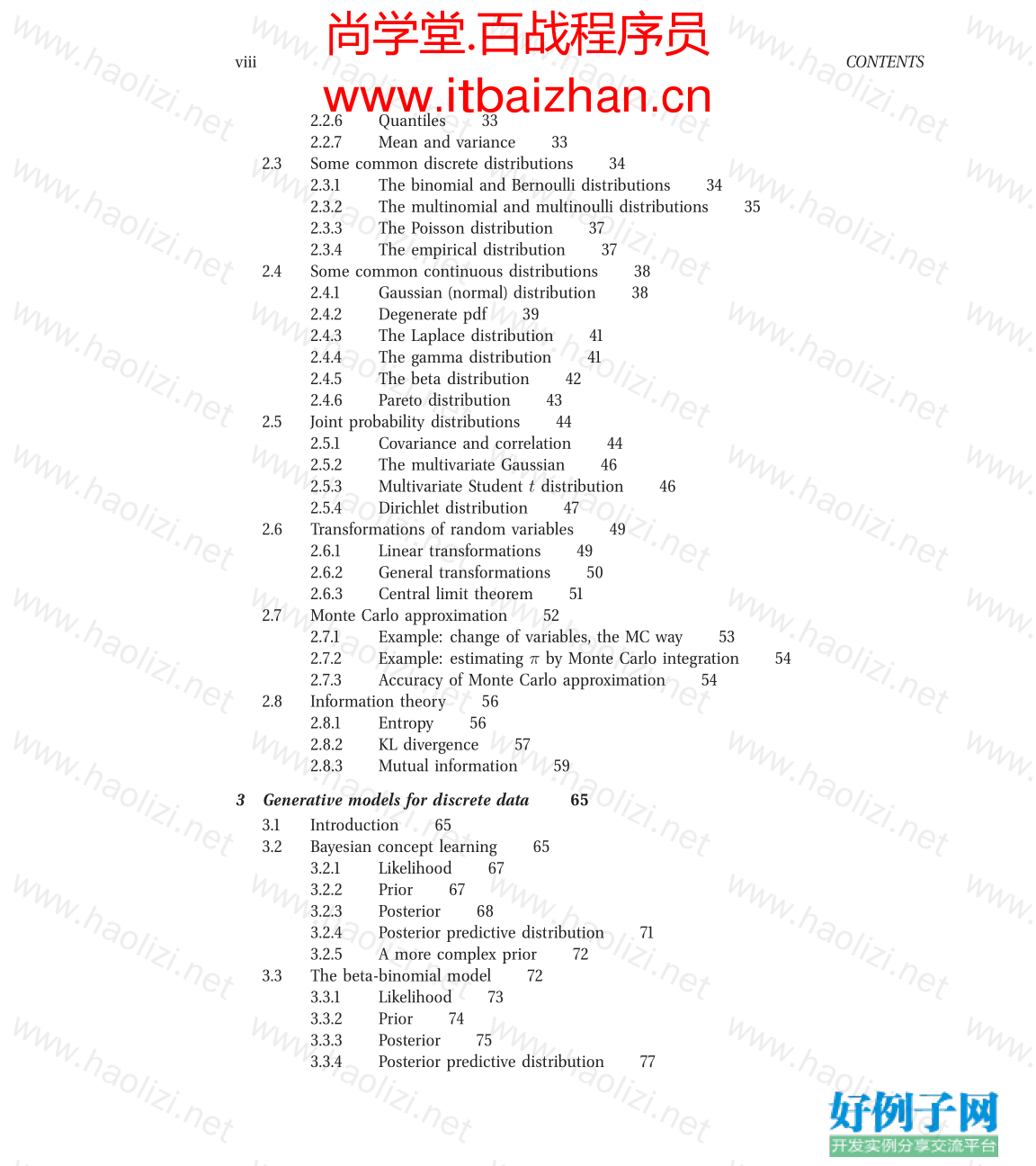
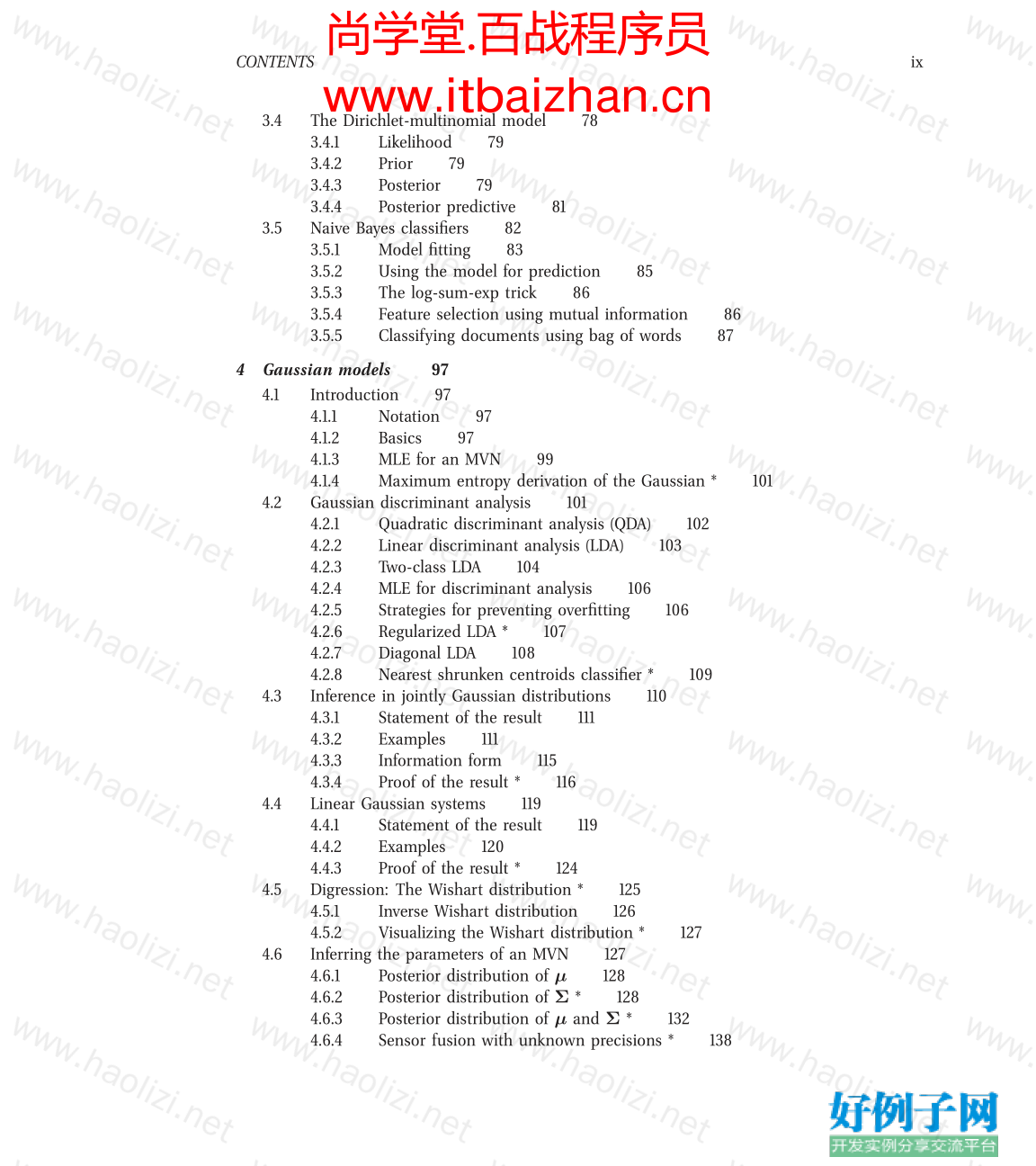
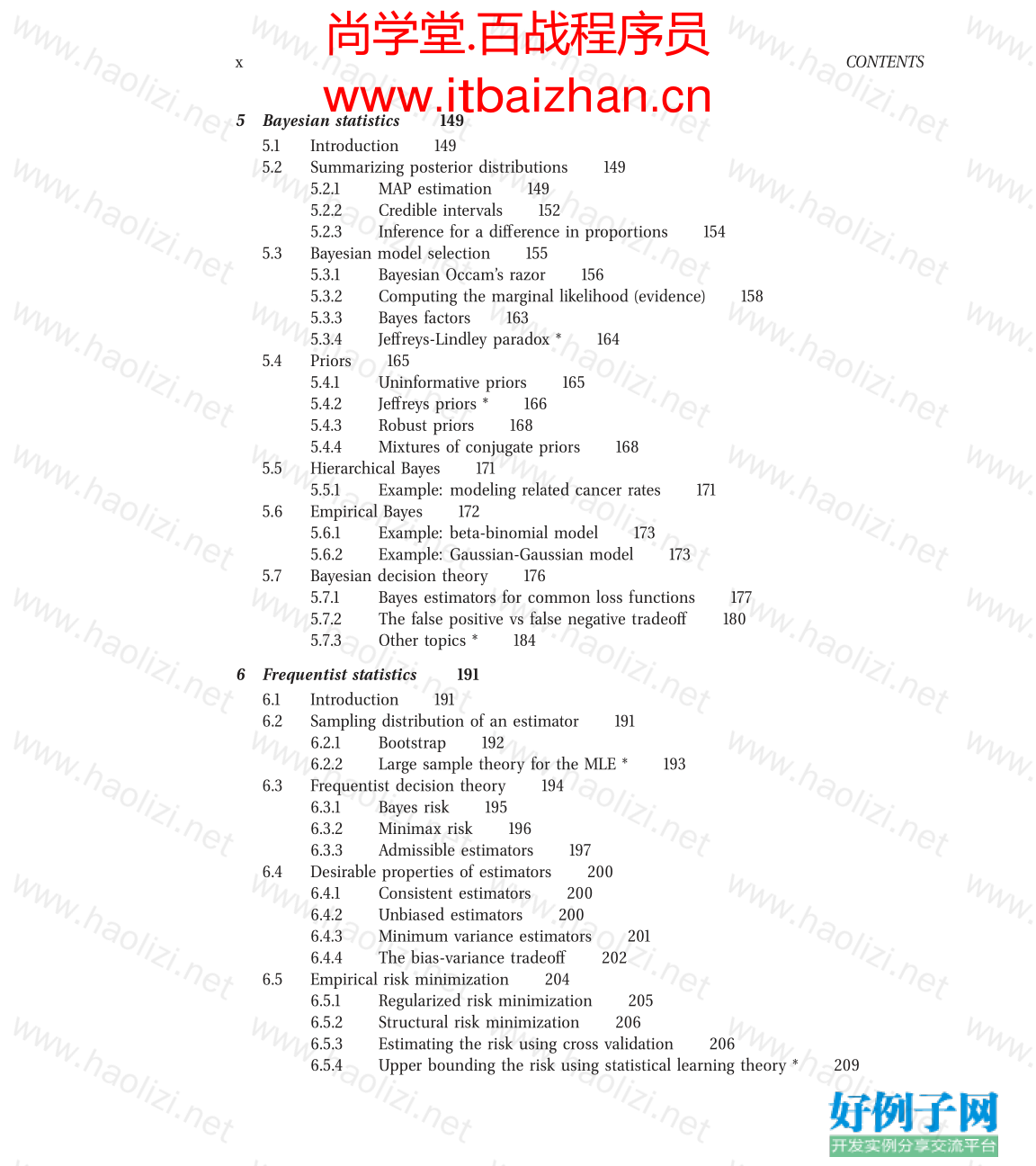
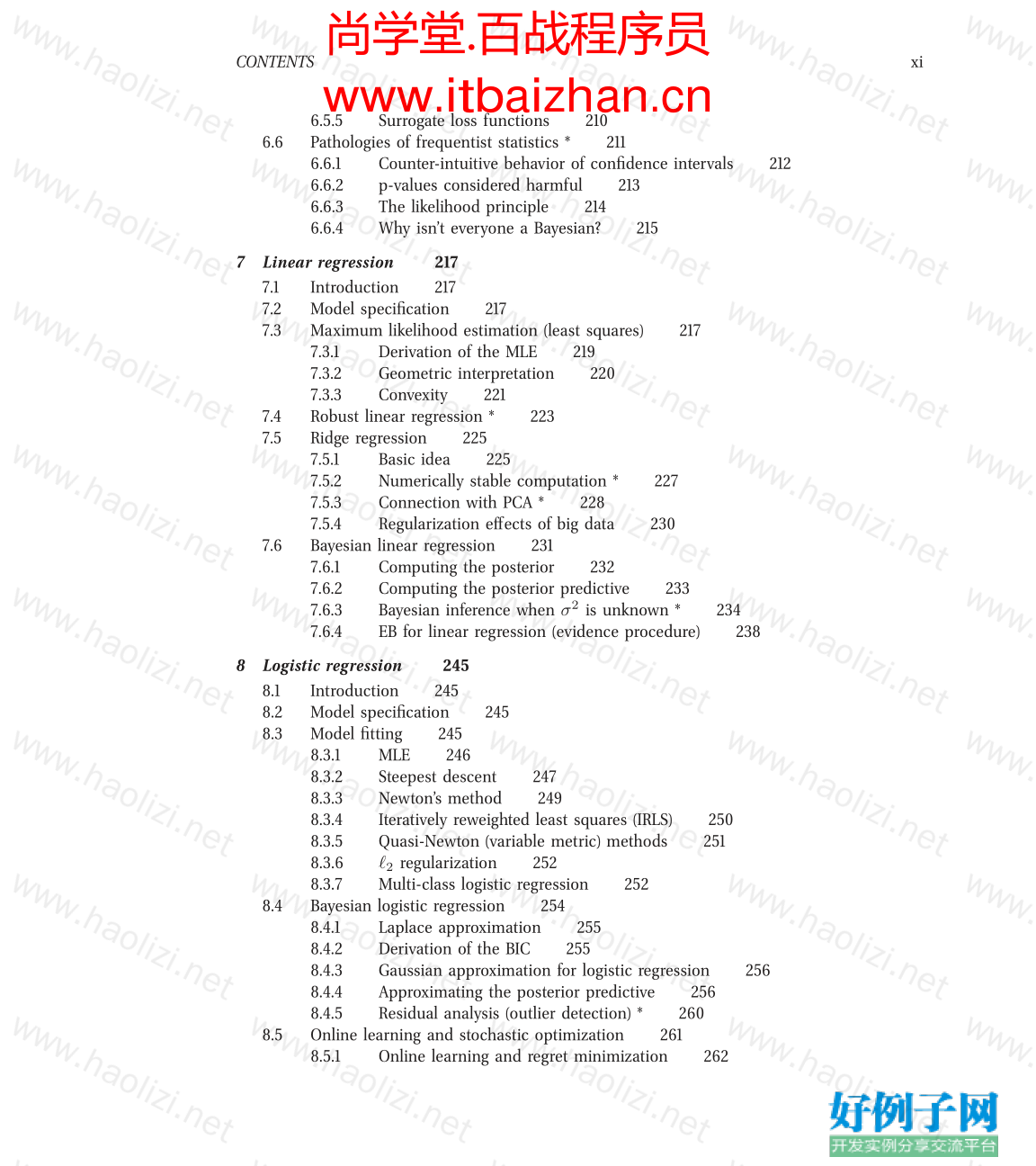
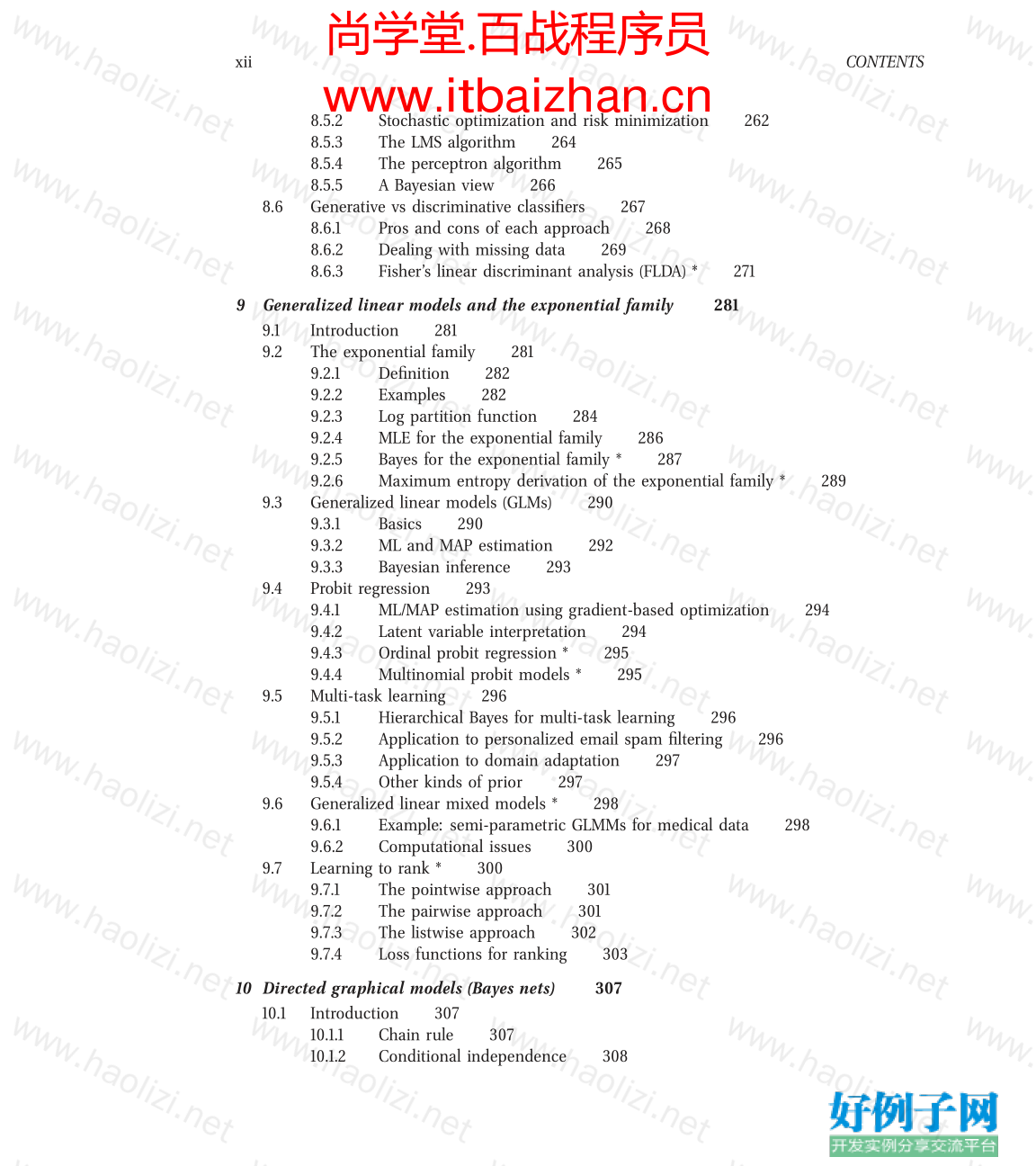
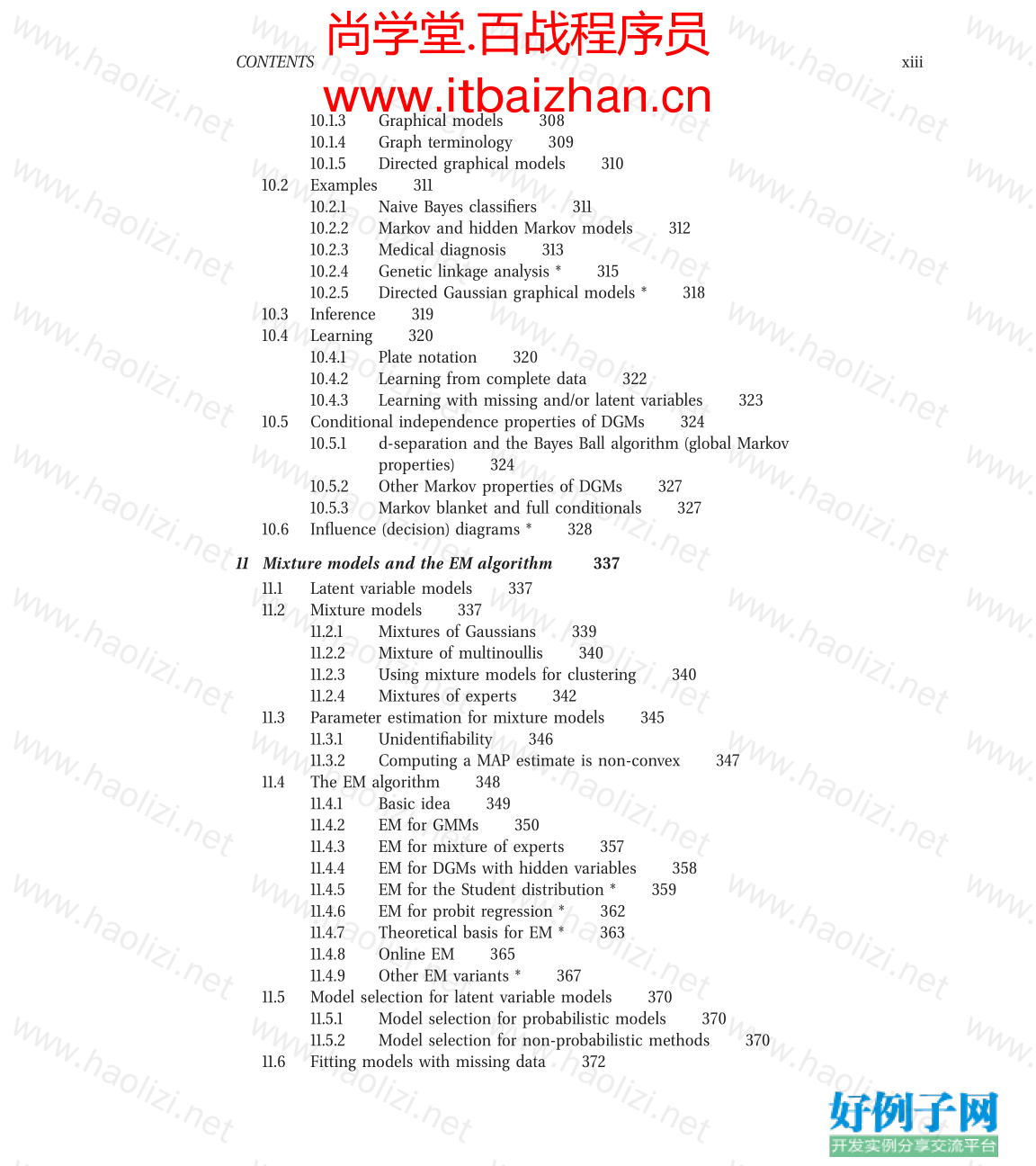
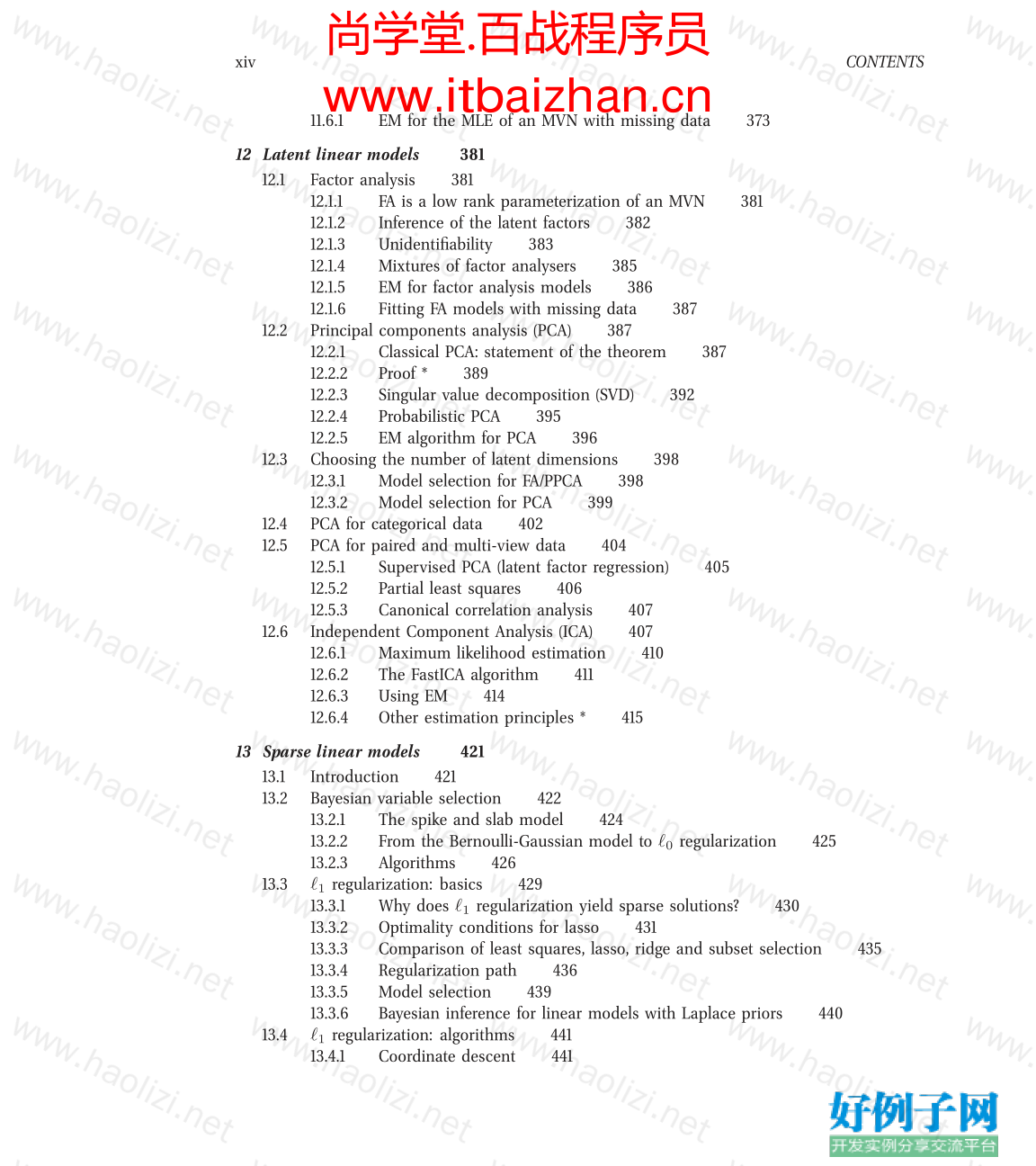
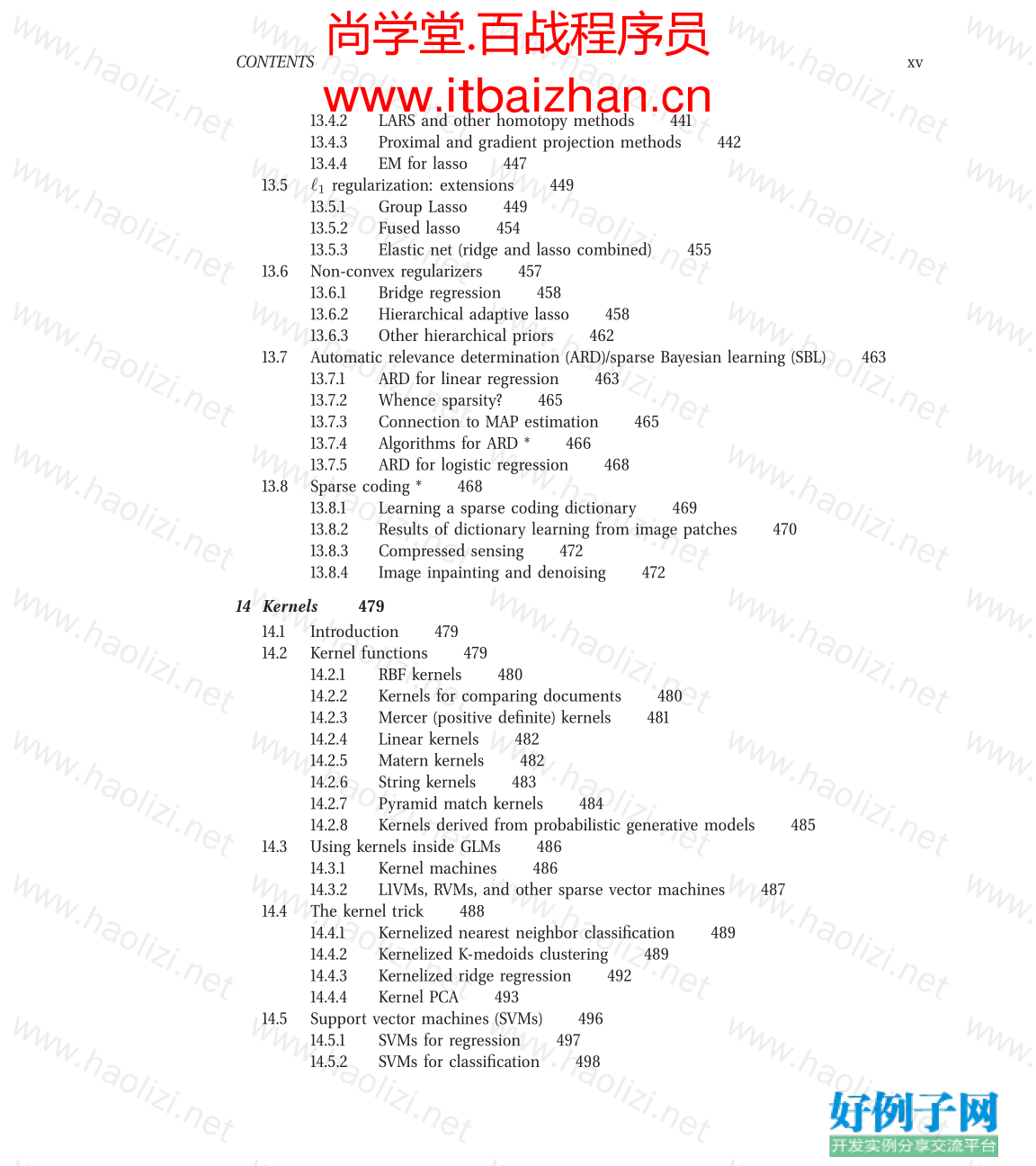
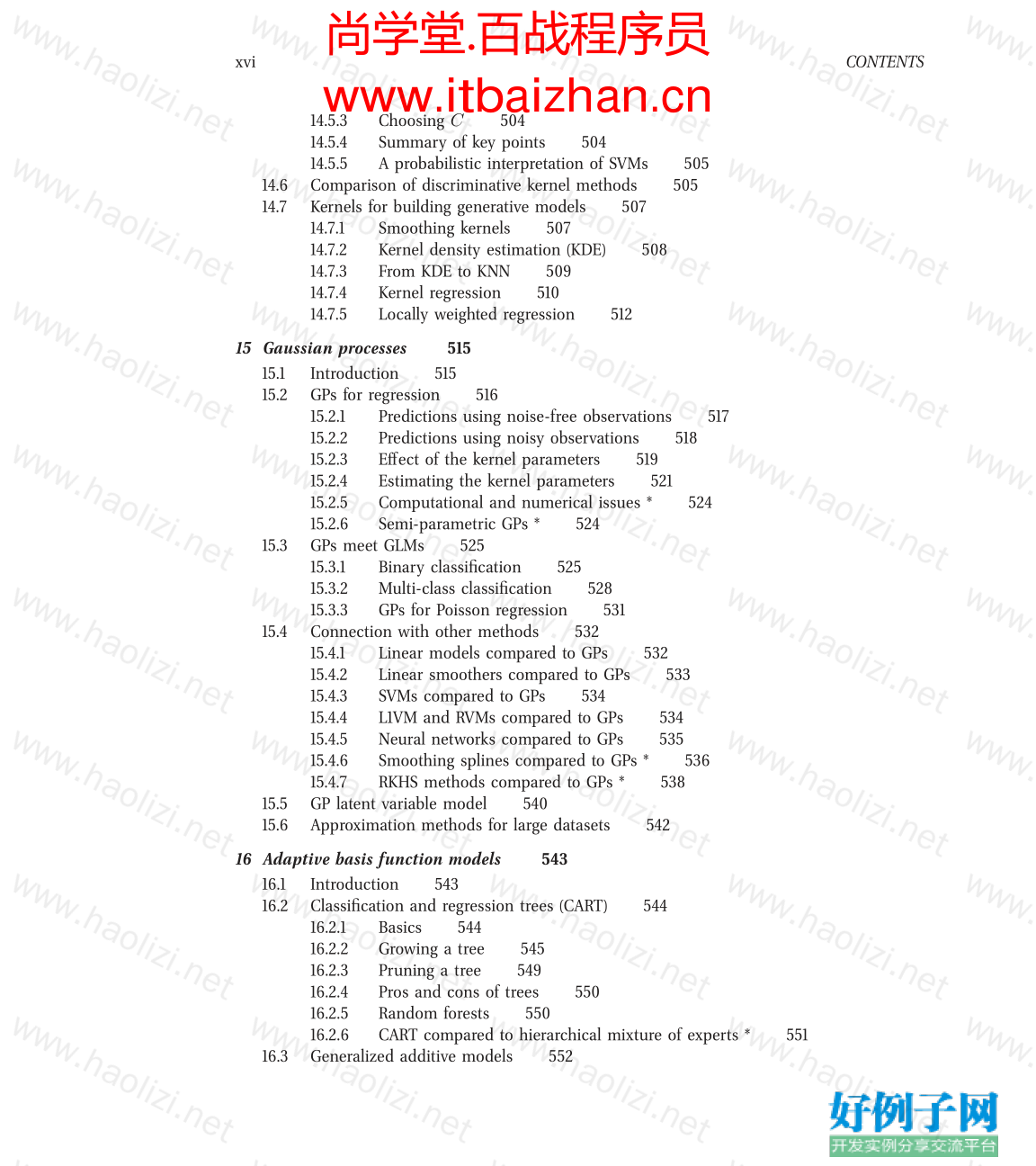
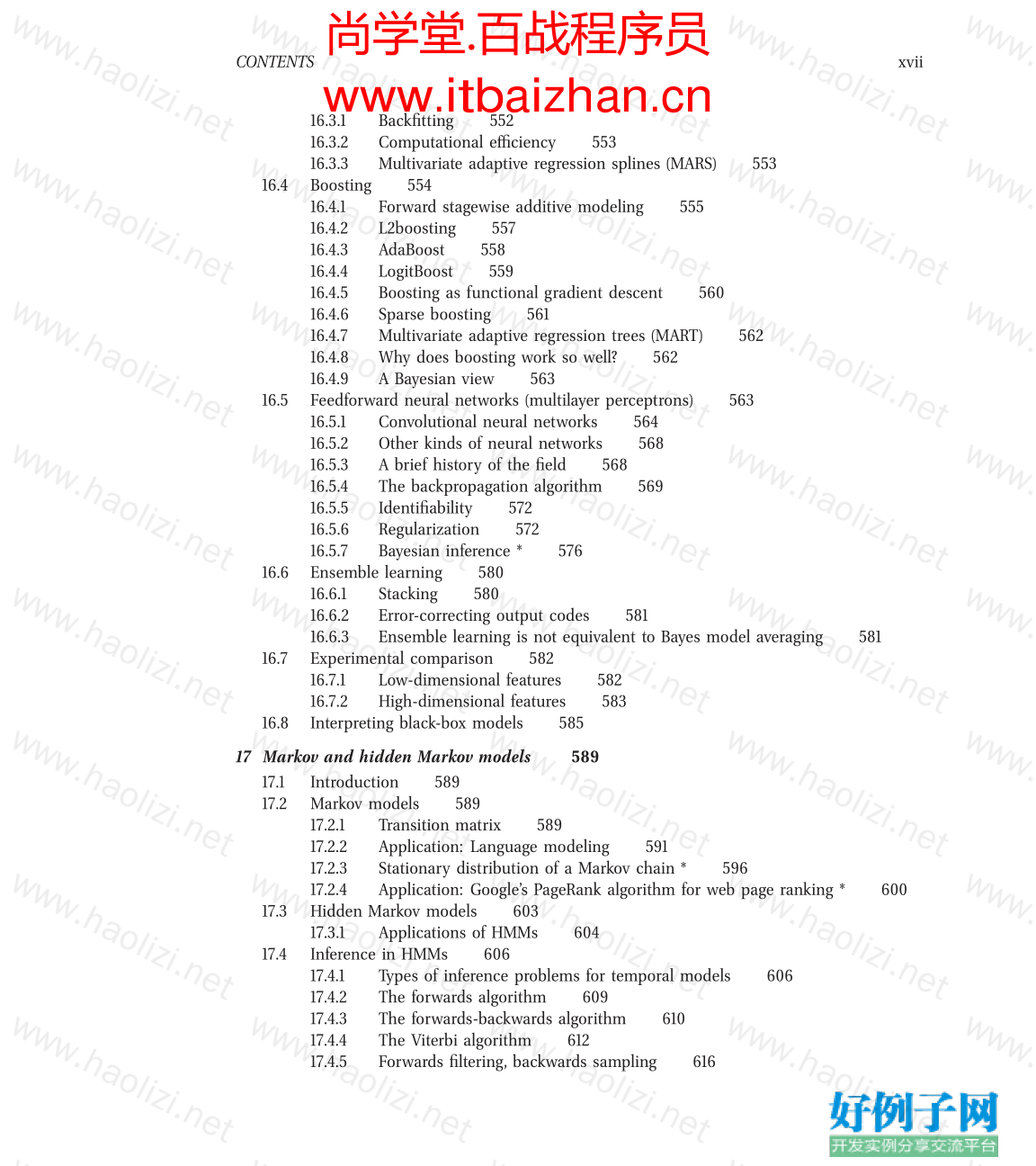

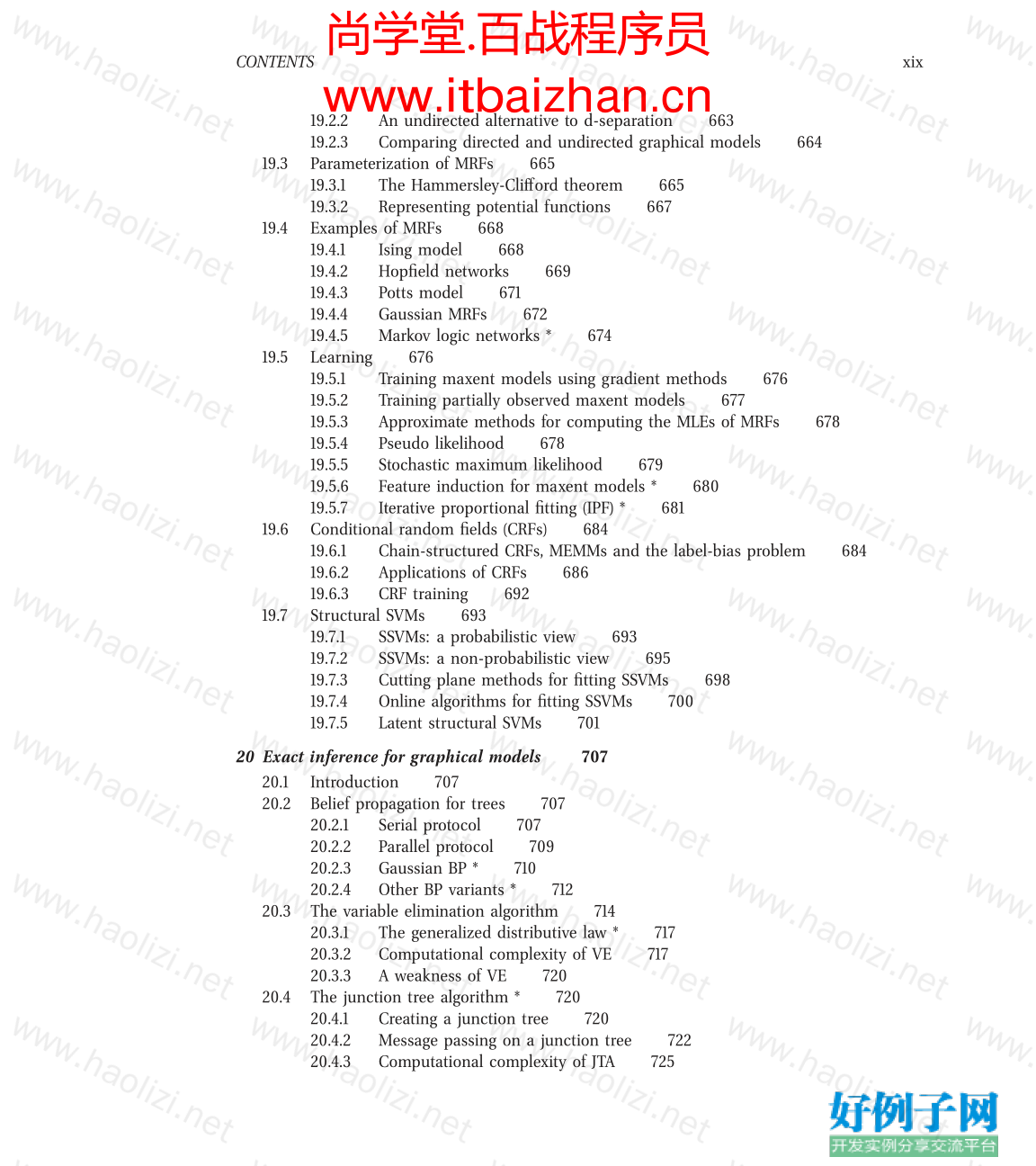
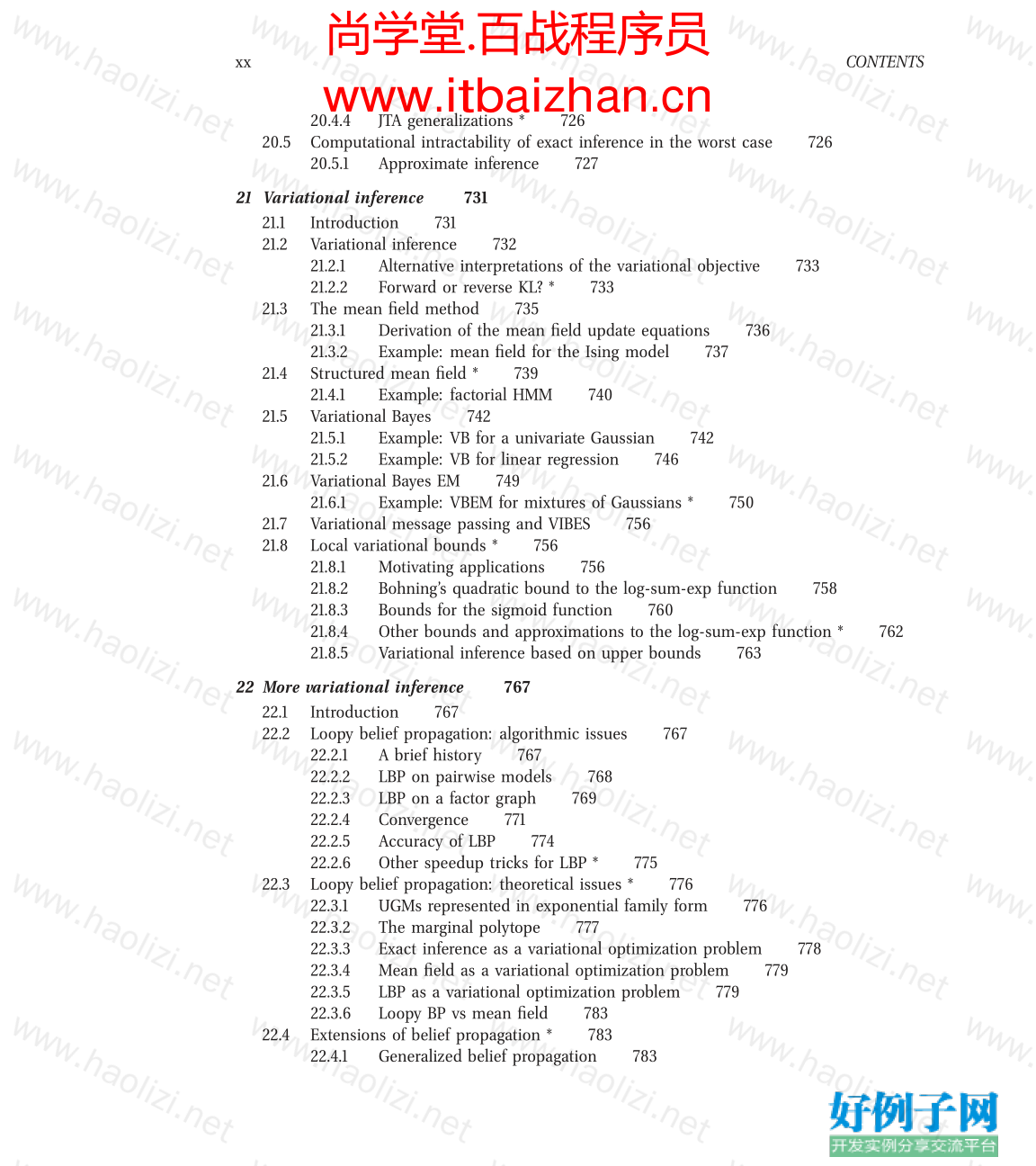

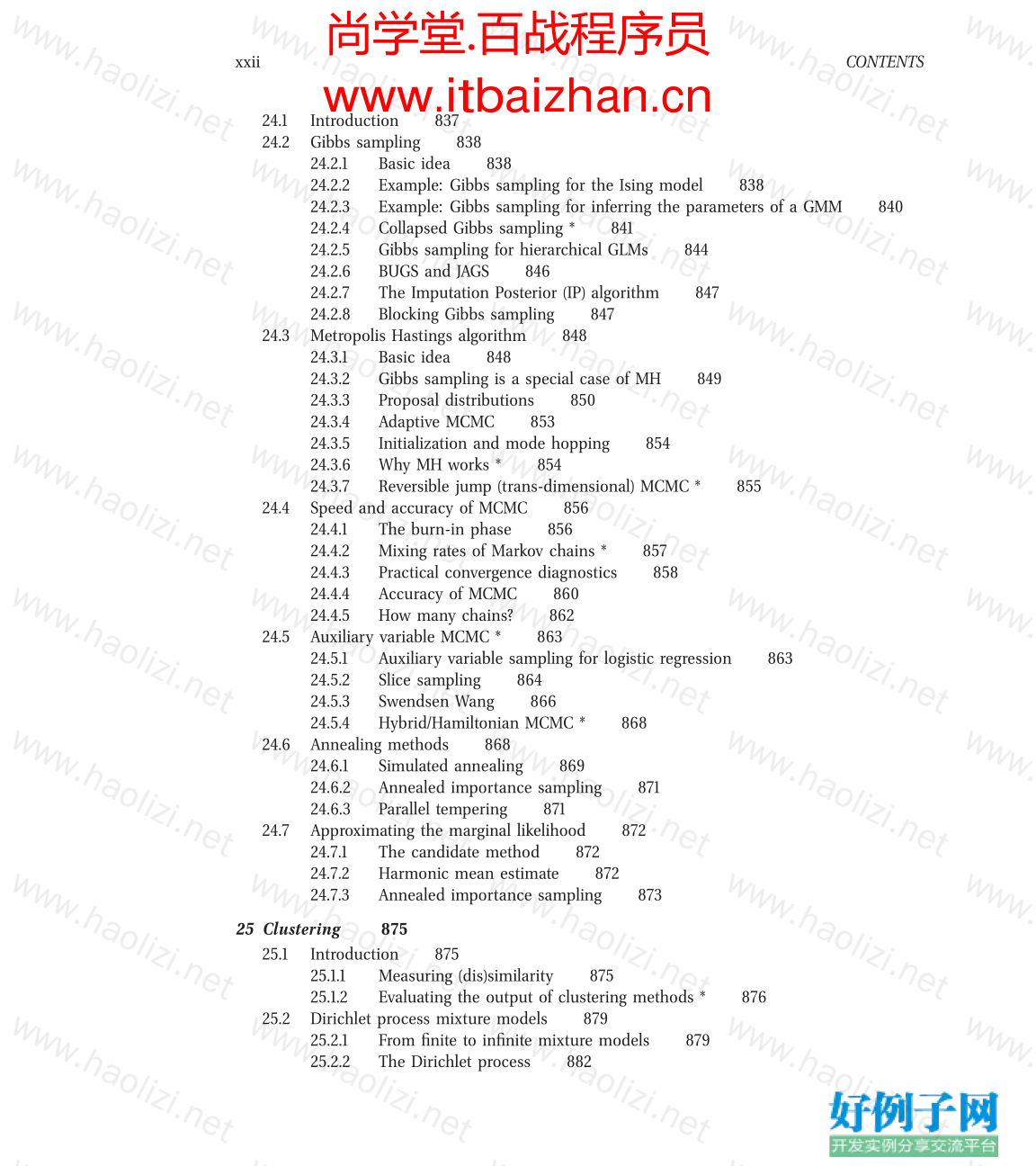
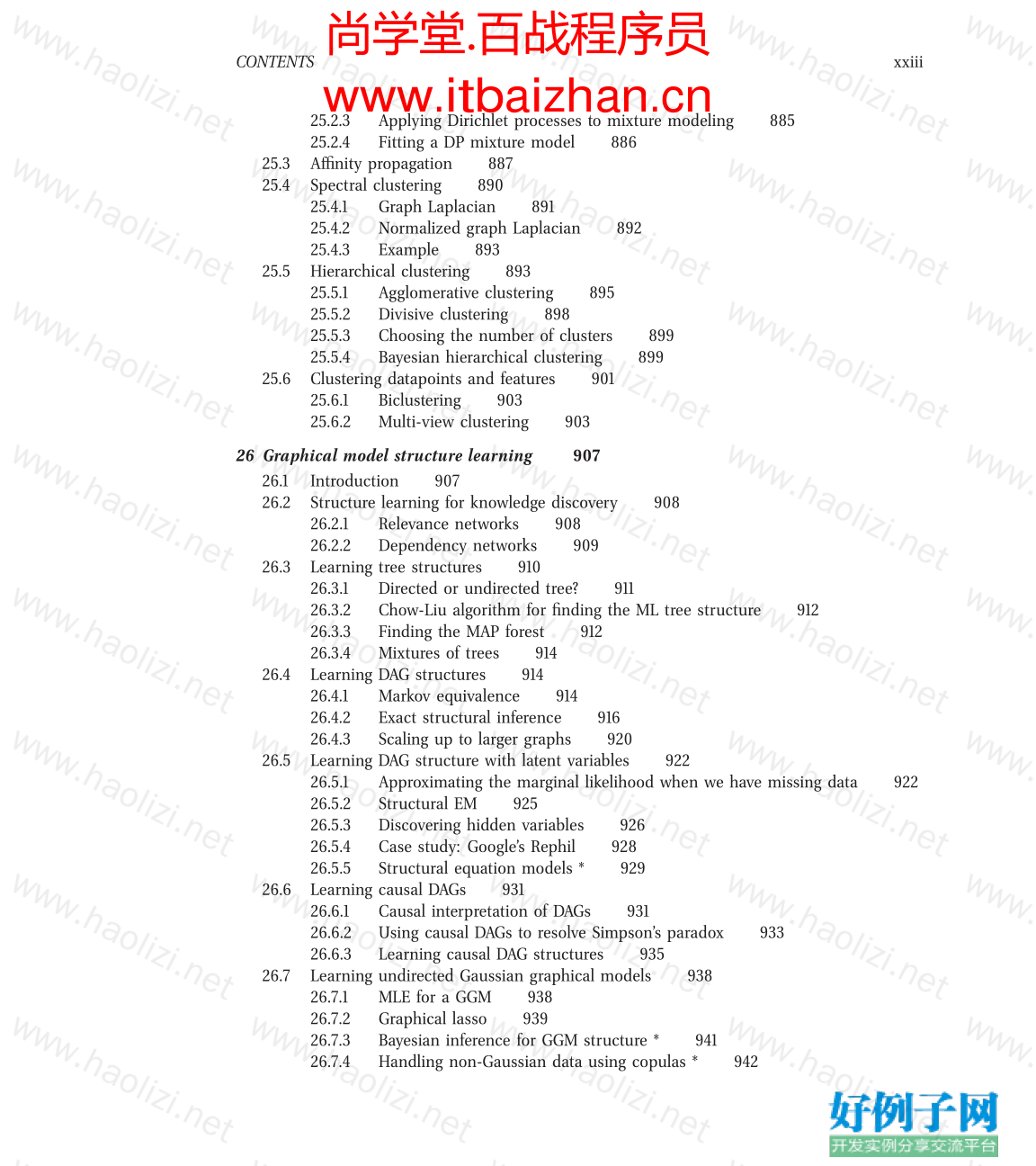
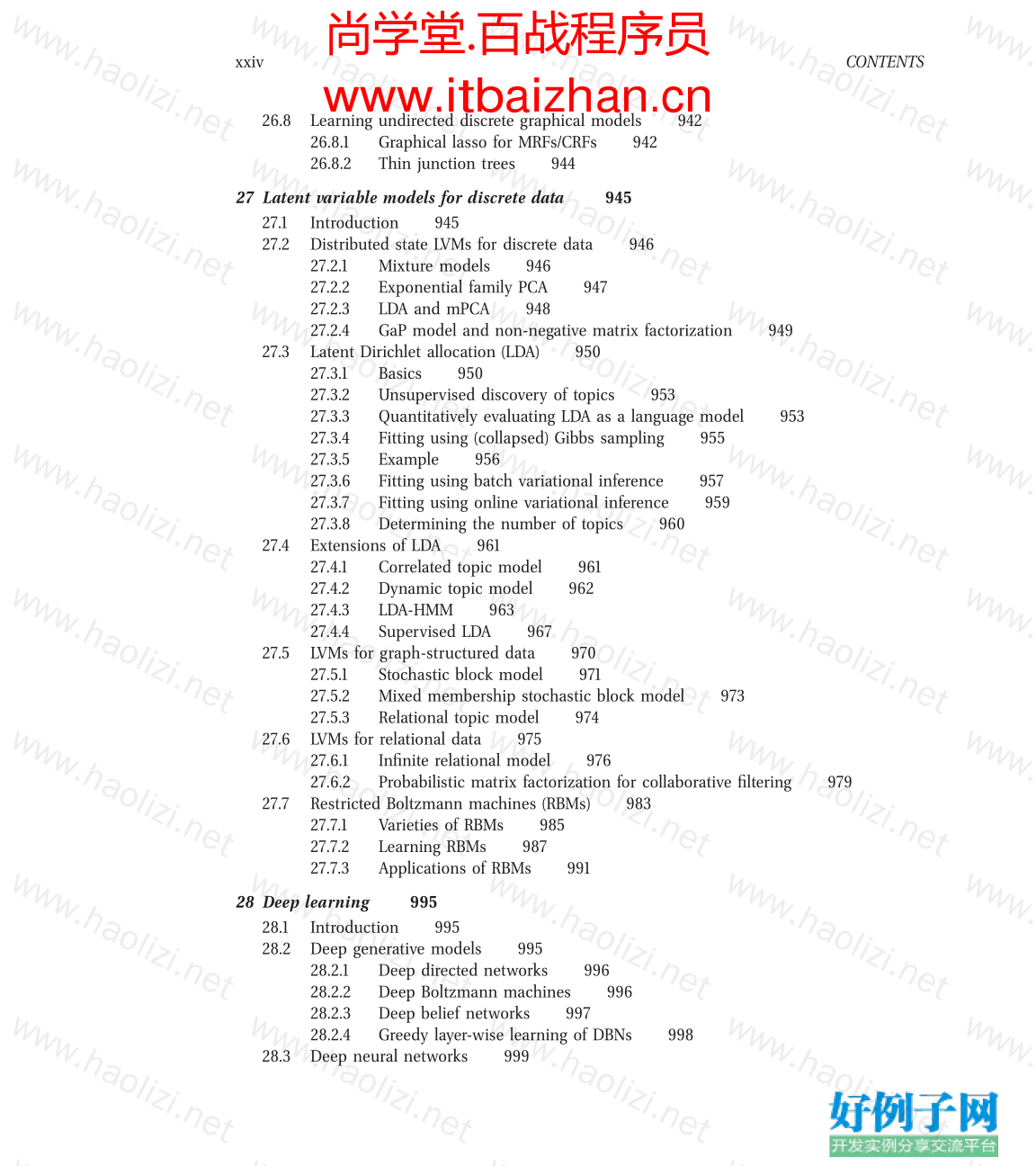
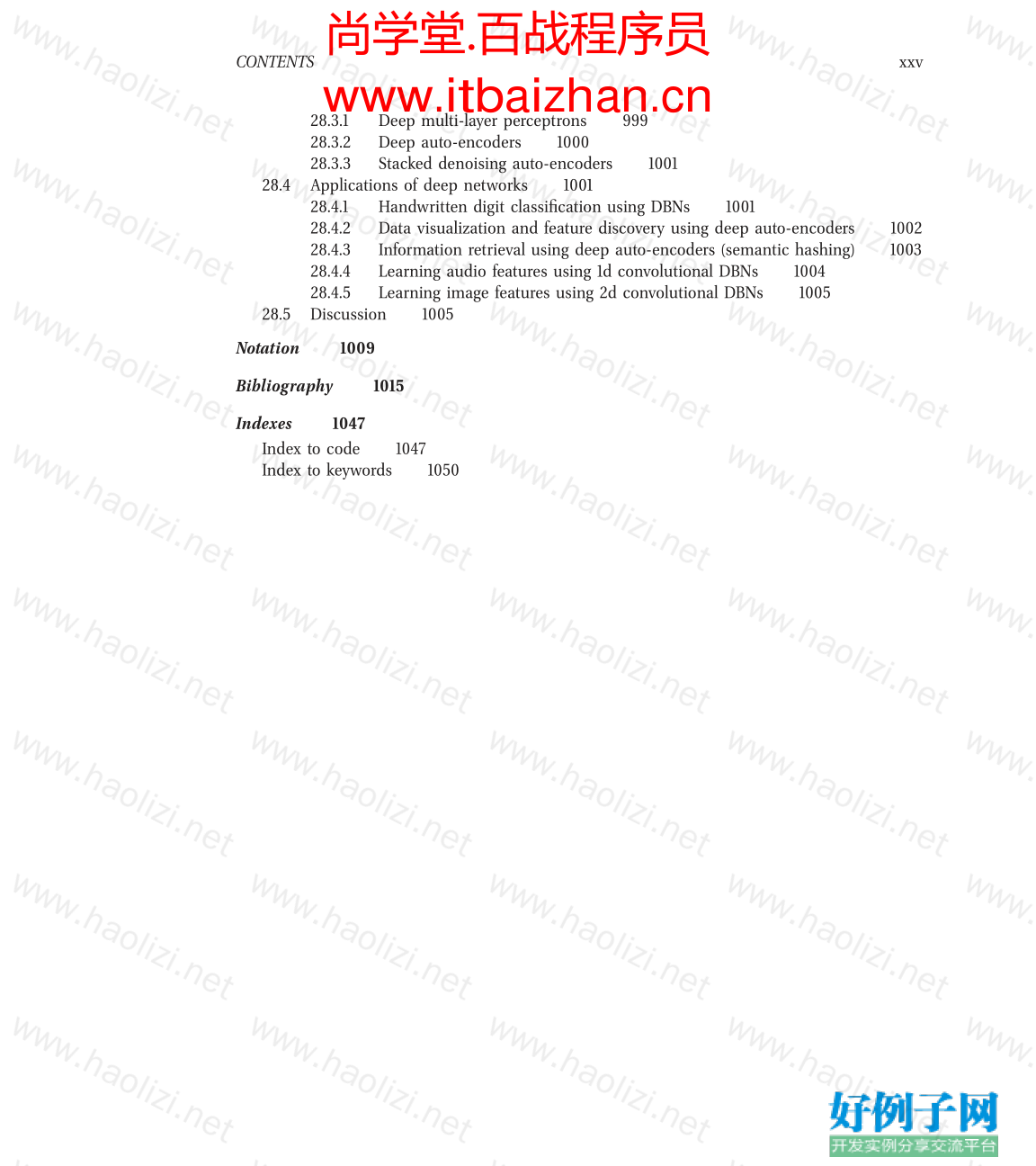
【核心代码】
Contents
Preface xxvii
1 Introduction 1
1.1 Machine learning: what and why? 1
1.1.1 Types of machine learning 2
1.2 Supervised learning 3
1.2.1 Classification 3
1.2.2 Regression 8
1.3 Unsupervised learning 9
1.3.1 Discovering clusters 10
1.3.2 Discovering latent factors 11
1.3.3 Discovering graph structure 13
1.3.4 Matrix completion 14
1.4 Some basic concepts in machine learning 16
1.4.1 Parametric vs non-parametric models 16
1.4.2 A simple non-parametric classifier: K-nearest neighbors 16
1.4.3 The curse of dimensionality 18
1.4.4 Parametric models for classification and regression 19
1.4.5 Linear regression 19
1.4.6 Logistic regression 21
1.4.7 Overfitting 22
1.4.8 Model selection 22
1.4.9 No free lunch theorem 24
2 Probability 27
2.1 Introduction 27
2.2 A brief review of probability theory 28
2.2.1 Discrete random variables 28
2.2.2 Fundamental rules 28
2.2.3 Bayes rule 29
2.2.4 Independence and conditional independence 30
2.2.5 Continuous random variables 32
尚学堂.百战程序员
www.itbaizhan.cn
viii CONTENTS
2.2.6 Quantiles 33
2.2.7 Mean and variance 33
2.3 Some common discrete distributions 34
2.3.1 The binomial and Bernoulli distributions 34
2.3.2 The multinomial and multinoulli distributions 35
2.3.3 The Poisson distribution 37
2.3.4 The empirical distribution 37
2.4 Some common continuous distributions 38
2.4.1 Gaussian (normal) distribution 38
2.4.2 Degenerate pdf 39
2.4.3 The Laplace distribution 41
2.4.4 The gamma distribution 41
2.4.5 The beta distribution 42
2.4.6 Pareto distribution 43
2.5 Joint probability distributions 44
2.5.1 Covariance and correlation 44
2.5.2 The multivariate Gaussian 46
2.5.3 Multivariate Student t distribution 46
2.5.4 Dirichlet distribution 47
2.6 Transformations of random variables 49
2.6.1 Linear transformations 49
2.6.2 General transformations 50
2.6.3 Central limit theorem 51
2.7 Monte Carlo approximation 52
2.7.1 Example: change of variables, the MC way 53
2.7.2 Example: estimating π by Monte Carlo integration 54
2.7.3 Accuracy of Monte Carlo approximation 54
2.8 Information theory 56
2.8.1 Entropy 56
2.8.2 KL divergence 57
2.8.3 Mutual information 59
3 Generative models for discrete data 65
3.1 Introduction 65
3.2 Bayesian concept learning 65
3.2.1 Likelihood 67
3.2.2 Prior 67
3.2.3 Posterior 68
3.2.4 Posterior predictive distribution 71
3.2.5 A more complex prior 72
3.3 The beta-binomial model 72
3.3.1 Likelihood 73
3.3.2 Prior 74
3.3.3 Posterior 75
3.3.4 Posterior predictive distribution 77
尚学堂.百战程序员
www.itbaizhan.cn
CONTENTS ix
3.4 The Dirichlet-multinomial model 78
3.4.1 Likelihood 79
3.4.2 Prior 79
3.4.3 Posterior 79
3.4.4 Posterior predictive 81
3.5 Naive Bayes classifiers 82
3.5.1 Model fitting 83
3.5.2 Using the model for prediction 85
3.5.3 The log-sum-exp trick 86
3.5.4 Feature selection using mutual information 86
3.5.5 Classifying documents using bag of words 87
4 Gaussian models 97
4.1 Introduction 97
4.1.1 Notation 97
4.1.2 Basics 97
4.1.3 MLE for an MVN 99
4.1.4 Maximum entropy derivation of the Gaussian * 101
4.2 Gaussian discriminant analysis 101
4.2.1 Quadratic discriminant analysis (QDA) 102
4.2.2 Linear discriminant analysis (LDA) 103
4.2.3 Two-class LDA 104
4.2.4 MLE for discriminant analysis 106
4.2.5 Strategies for preventing overfitting 106
4.2.6 Regularized LDA * 107
4.2.7 Diagonal LDA 108
4.2.8 Nearest shrunken centroids classifier * 109
4.3 Inference in jointly Gaussian distributions 110
4.3.1 Statement of the result 111
4.3.2 Examples 111
4.3.3 Information form 115
4.3.4 Proof of the result * 116
4.4 Linear Gaussian systems 119
4.4.1 Statement of the result 119
4.4.2 Examples 120
4.4.3 Proof of the result * 124
4.5 Digression: The Wishart distribution * 125
4.5.1 Inverse Wishart distribution 126
4.5.2 Visualizing the Wishart distribution * 127
4.6 Inferring the parameters of an MVN 127
4.6.1 Posterior distribution of μ 128
4.6.2 Posterior distribution of Σ * 128
4.6.3 Posterior distribution of μ and Σ * 132
4.6.4 Sensor fusion with unknown precisions * 138
尚学堂.百战程序员
www.itbaizhan.cn
x CONTENTS
5 Bayesian statistics 149
5.1 Introduction 149
5.2 Summarizing posterior distributions 149
5.2.1 MAP estimation 149
5.2.2 Credible intervals 152
5.2.3 Inference for a difference in proportions 154
5.3 Bayesian model selection 155
5.3.1 Bayesian Occam’s razor 156
5.3.2 Computing the marginal likelihood (evidence) 158
5.3.3 Bayes factors 163
5.3.4 Jeffreys-Lindley paradox * 164
5.4 Priors 165
5.4.1 Uninformative priors 165
5.4.2 Jeffreys priors * 166
5.4.3 Robust priors 168
5.4.4 Mixtures of conjugate priors 168
5.5 Hierarchical Bayes 171
5.5.1 Example: modeling related cancer rates 171
5.6 Empirical Bayes 172
5.6.1 Example: beta-binomial model 173
5.6.2 Example: Gaussian-Gaussian model 173
5.7 Bayesian decision theory 176
5.7.1 Bayes estimators for common loss functions 177
5.7.2 The false positive vs false negative tradeoff 180
5.7.3 Other topics * 184
6 Frequentist statistics 191
6.1 Introduction 191
6.2 Sampling distribution of an estimator 191
6.2.1 Bootstrap 192
6.2.2 Large sample theory for the MLE * 193
6.3 Frequentist decision theory 194
6.3.1 Bayes risk 195
6.3.2 Minimax risk 196
6.3.3 Admissible estimators 197
6.4 Desirable properties of estimators 200
6.4.1 Consistent estimators 200
6.4.2 Unbiased estimators 200
6.4.3 Minimum variance estimators 201
6.4.4 The bias-variance tradeoff 202
6.5 Empirical risk minimization 204
6.5.1 Regularized risk minimization 205
6.5.2 Structural risk minimization 206
6.5.3 Estimating the risk using cross validation 206
6.5.4 Upper bounding the risk using statistical learning theory * 209
尚学堂.百战程序员
www.itbaizhan.cn
CONTENTS xi
6.5.5 Surrogate loss functions 210
6.6 Pathologies of frequentist statistics * 211
6.6.1 Counter-intuitive behavior of confidence intervals 212
6.6.2 p-values considered harmful 213
6.6.3 The likelihood principle 214
6.6.4 Why isn’t everyone a Bayesian? 215
7 Linear regression 217
7.1 Introduction 217
7.2 Model specification 217
7.3 Maximum likelihood estimation (least squares) 217
7.3.1 Derivation of the MLE 219
7.3.2 Geometric interpretation 220
7.3.3 Convexity 221
7.4 Robust linear regression * 223
7.5 Ridge regression 225
7.5.1 Basic idea 225
7.5.2 Numerically stable computation * 227
7.5.3 Connection with PCA * 228
7.5.4 Regularization effects of big data 230
7.6 Bayesian linear regression 231
7.6.1 Computing the posterior 232
7.6.2 Computing the posterior predictive 233
7.6.3 Bayesian inference when σ 2 is unknown * 234
7.6.4 EB for linear regression (evidence procedure) 238
8 Logistic regression 245
8.1 Introduction 245
8.2 Model specification 245
8.3 Model fitting 245
8.3.1 MLE 246
8.3.2 Steepest descent 247
8.3.3 Newton’s method 249
8.3.4 Iteratively reweighted least squares (IRLS) 250
8.3.5 Quasi-Newton (variable metric) methods 251
8.3.6 ? 2 regularization 252
8.3.7 Multi-class logistic regression 252
8.4 Bayesian logistic regression 254
8.4.1 Laplace approximation 255
8.4.2 Derivation of the BIC 255
8.4.3 Gaussian approximation for logistic regression 256
8.4.4 Approximating the posterior predictive 256
8.4.5 Residual analysis (outlier detection) * 260
8.5 Online learning and stochastic optimization 261
8.5.1 Online learning and regret minimization 262
尚学堂.百战程序员
www.itbaizhan.cn
xii CONTENTS
8.5.2 Stochastic optimization and risk minimization 262
8.5.3 The LMS algorithm 264
8.5.4 The perceptron algorithm 265
8.5.5 A Bayesian view 266
8.6 Generative vs discriminative classifiers 267
8.6.1 Pros and cons of each approach 268
8.6.2 Dealing with missing data 269
8.6.3 Fisher’s linear discriminant analysis (FLDA) * 271
9 Generalized linear models and the exponential family 281
9.1 Introduction 281
9.2 The exponential family 281
9.2.1 Definition 282
9.2.2 Examples 282
9.2.3 Log partition function 284
9.2.4 MLE for the exponential family 286
9.2.5 Bayes for the exponential family * 287
9.2.6 Maximum entropy derivation of the exponential family * 289
9.3 Generalized linear models (GLMs) 290
9.3.1 Basics 290
9.3.2 ML and MAP estimation 292
9.3.3 Bayesian inference 293
9.4 Probit regression 293
9.4.1 ML/MAP estimation using gradient-based optimization 294
9.4.2 Latent variable interpretation 294
9.4.3 Ordinal probit regression * 295
9.4.4 Multinomial probit models * 295
9.5 Multi-task learning 296
9.5.1 Hierarchical Bayes for multi-task learning 296
9.5.2 Application to personalized email spam filtering 296
9.5.3 Application to domain adaptation 297
9.5.4 Other kinds of prior 297
9.6 Generalized linear mixed models * 298
9.6.1 Example: semi-parametric GLMMs for medical data 298
9.6.2 Computational issues 300
9.7 Learning to rank * 300
9.7.1 The pointwise approach 301
9.7.2 The pairwise approach 301
9.7.3 The listwise approach 302
9.7.4 Loss functions for ranking 303
10 Directed graphical models (Bayes nets) 307
10.1 Introduction 307
10.1.1 Chain rule 307
10.1.2 Conditional independence 308
尚学堂.百战程序员
www.itbaizhan.cn
CONTENTS xiii
10.1.3 Graphical models 308
10.1.4 Graph terminology 309
10.1.5 Directed graphical models 310
10.2 Examples 311
10.2.1 Naive Bayes classifiers 311
10.2.2 Markov and hidden Markov models 312
10.2.3 Medical diagnosis 313
10.2.4 Genetic linkage analysis * 315
10.2.5 Directed Gaussian graphical models * 318
10.3 Inference 319
10.4 Learning 320
10.4.1 Plate notation 320
10.4.2 Learning from complete data 322
10.4.3 Learning with missing and/or latent variables 323
10.5 Conditional independence properties of DGMs 324
10.5.1 d-separation and the Bayes Ball algorithm (global Markov
properties) 324
10.5.2 Other Markov properties of DGMs 327
10.5.3 Markov blanket and full conditionals 327
10.6 Influence (decision) diagrams * 328
11 Mixture models and the EM algorithm 337
11.1 Latent variable models 337
11.2 Mixture models 337
11.2.1 Mixtures of Gaussians 339
11.2.2 Mixture of multinoullis 340
11.2.3 Using mixture models for clustering 340
11.2.4 Mixtures of experts 342
11.3 Parameter estimation for mixture models 345
11.3.1 Unidentifiability 346
11.3.2 Computing a MAP estimate is non-convex 347
11.4 The EM algorithm 348
11.4.1 Basic idea 349
11.4.2 EM for GMMs 350
11.4.3 EM for mixture of experts 357
11.4.4 EM for DGMs with hidden variables 358
11.4.5 EM for the Student distribution * 359
11.4.6 EM for probit regression * 362
11.4.7 Theoretical basis for EM * 363
11.4.8 Online EM 365
11.4.9 Other EM variants * 367
11.5 Model selection for latent variable models 370
11.5.1 Model selection for probabilistic models 370
11.5.2 Model selection for non-probabilistic methods 370
11.6 Fitting models with missing data 372
尚学堂.百战程序员
www.itbaizhan.cn
xiv CONTENTS
11.6.1 EM for the MLE of an MVN with missing data 373
12 Latent linear models 381
12.1 Factor analysis 381
12.1.1 FA is a low rank parameterization of an MVN 381
12.1.2 Inference of the latent factors 382
12.1.3 Unidentifiability 383
12.1.4 Mixtures of factor analysers 385
12.1.5 EM for factor analysis models 386
12.1.6 Fitting FA models with missing data 387
12.2 Principal components analysis (PCA) 387
12.2.1 Classical PCA: statement of the theorem 387
12.2.2 Proof * 389
12.2.3 Singular value decomposition (SVD) 392
12.2.4 Probabilistic PCA 395
12.2.5 EM algorithm for PCA 396
12.3 Choosing the number of latent dimensions 398
12.3.1 Model selection for FA/PPCA 398
12.3.2 Model selection for PCA 399
12.4 PCA for categorical data 402
12.5 PCA for paired and multi-view data 404
12.5.1 Supervised PCA (latent factor regression) 405
12.5.2 Partial least squares 406
12.5.3 Canonical correlation analysis 407
12.6 Independent Component Analysis (ICA) 407
12.6.1 Maximum likelihood estimation 410
12.6.2 The FastICA algorithm 411
12.6.3 Using EM 414
12.6.4 Other estimation principles * 415
13 Sparse linear models 421
13.1 Introduction 421
13.2 Bayesian variable selection 422
13.2.1 The spike and slab model 424
13.2.2 From the Bernoulli-Gaussian model to ? 0 regularization 425
13.2.3 Algorithms 426
13.3 ? 1 regularization: basics 429
13.3.1 Why does ? 1 regularization yield sparse solutions? 430
13.3.2 Optimality conditions for lasso 431
13.3.3 Comparison of least squares, lasso, ridge and subset selection 435
13.3.4 Regularization path 436
13.3.5 Model selection 439
13.3.6 Bayesian inference for linear models with Laplace priors 440
13.4 ? 1 regularization: algorithms 441
13.4.1 Coordinate descent 441
尚学堂.百战程序员
www.itbaizhan.cn
CONTENTS xv
13.4.2 LARS and other homotopy methods 441
13.4.3 Proximal and gradient projection methods 442
13.4.4 EM for lasso 447
13.5 ? 1 regularization: extensions 449
13.5.1 Group Lasso 449
13.5.2 Fused lasso 454
13.5.3 Elastic net (ridge and lasso combined) 455
13.6 Non-convex regularizers 457
13.6.1 Bridge regression 458
13.6.2 Hierarchical adaptive lasso 458
13.6.3 Other hierarchical priors 462
13.7 Automatic relevance determination (ARD)/sparse Bayesian learning (SBL) 463
13.7.1 ARD for linear regression 463
13.7.2 Whence sparsity? 465
13.7.3 Connection to MAP estimation 465
13.7.4 Algorithms for ARD * 466
13.7.5 ARD for logistic regression 468
13.8 Sparse coding * 468
13.8.1 Learning a sparse coding dictionary 469
13.8.2 Results of dictionary learning from image patches 470
13.8.3 Compressed sensing 472
13.8.4 Image inpainting and denoising 472
14 Kernels 479
14.1 Introduction 479
14.2 Kernel functions 479
14.2.1 RBF kernels 480
14.2.2 Kernels for comparing documents 480
14.2.3 Mercer (positive definite) kernels 481
14.2.4 Linear kernels 482
14.2.5 Matern kernels 482
14.2.6 String kernels 483
14.2.7 Pyramid match kernels 484
14.2.8 Kernels derived from probabilistic generative models 485
14.3 Using kernels inside GLMs 486
14.3.1 Kernel machines 486
14.3.2 L1VMs, RVMs, and other sparse vector machines 487
14.4 The kernel trick 488
14.4.1 Kernelized nearest neighbor classification 489
14.4.2 Kernelized K-medoids clustering 489
14.4.3 Kernelized ridge regression 492
14.4.4 Kernel PCA 493
14.5 Support vector machines (SVMs) 496
14.5.1 SVMs for regression 497
14.5.2 SVMs for classification 498
尚学堂.百战程序员
www.itbaizhan.cn
xvi CONTENTS
14.5.3 Choosing C 504
14.5.4 Summary of key points 504
14.5.5 A probabilistic interpretation of SVMs 505
14.6 Comparison of discriminative kernel methods 505
14.7 Kernels for building generative models 507
14.7.1 Smoothing kernels 507
14.7.2 Kernel density estimation (KDE) 508
14.7.3 From KDE to KNN 509
14.7.4 Kernel regression 510
14.7.5 Locally weighted regression 512
15 Gaussian processes 515
15.1 Introduction 515
15.2 GPs for regression 516
15.2.1 Predictions using noise-free observations 517
15.2.2 Predictions using noisy observations 518
15.2.3 Effect of the kernel parameters 519
15.2.4 Estimating the kernel parameters 521
15.2.5 Computational and numerical issues * 524
15.2.6 Semi-parametric GPs * 524
15.3 GPs meet GLMs 525
15.3.1 Binary classification 525
15.3.2 Multi-class classification 528
15.3.3 GPs for Poisson regression 531
15.4 Connection with other methods 532
15.4.1 Linear models compared to GPs 532
15.4.2 Linear smoothers compared to GPs 533
15.4.3 SVMs compared to GPs 534
15.4.4 L1VM and RVMs compared to GPs 534
15.4.5 Neural networks compared to GPs 535
15.4.6 Smoothing splines compared to GPs * 536
15.4.7 RKHS methods compared to GPs * 538
15.5 GP latent variable model 540
15.6 Approximation methods for large datasets 542
16 Adaptive basis function models 543
16.1 Introduction 543
16.2 Classification and regression trees (CART) 544
16.2.1 Basics 544
16.2.2 Growing a tree 545
16.2.3 Pruning a tree 549
16.2.4 Pros and cons of trees 550
16.2.5 Random forests 550
16.2.6 CART compared to hierarchical mixture of experts * 551
16.3 Generalized additive models 552
尚学堂.百战程序员
www.itbaizhan.cn
CONTENTS xvii
16.3.1 Backfitting 552
16.3.2 Computational efficiency 553
16.3.3 Multivariate adaptive regression splines (MARS) 553
16.4 Boosting 554
16.4.1 Forward stagewise additive modeling 555
16.4.2 L2boosting 557
16.4.3 AdaBoost 558
16.4.4 LogitBoost 559
16.4.5 Boosting as functional gradient descent 560
16.4.6 Sparse boosting 561
16.4.7 Multivariate adaptive regression trees (MART) 562
16.4.8 Why does boosting work so well? 562
16.4.9 A Bayesian view 563
16.5 Feedforward neural networks (multilayer perceptrons) 563
16.5.1 Convolutional neural networks 564
16.5.2 Other kinds of neural networks 568
16.5.3 A brief history of the field 568
16.5.4 The backpropagation algorithm 569
16.5.5 Identifiability 572
16.5.6 Regularization 572
16.5.7 Bayesian inference * 576
16.6 Ensemble learning 580
16.6.1 Stacking 580
16.6.2 Error-correcting output codes 581
16.6.3 Ensemble learning is not equivalent to Bayes model averaging 581
16.7 Experimental comparison 582
16.7.1 Low-dimensional features 582
16.7.2 High-dimensional features 583
16.8 Interpreting black-box models 585
17 Markov and hidden Markov models 589
17.1 Introduction 589
17.2 Markov models 589
17.2.1 Transition matrix 589
17.2.2 Application: Language modeling 591
17.2.3 Stationary distribution of a Markov chain * 596
17.2.4 Application: Google’s PageRank algorithm for web page ranking * 600
17.3 Hidden Markov models 603
17.3.1 Applications of HMMs 604
17.4 Inference in HMMs 606
17.4.1 Types of inference problems for temporal models 606
17.4.2 The forwards algorithm 609
17.4.3 The forwards-backwards algorithm 610
17.4.4 The Viterbi algorithm 612
17.4.5 Forwards filtering, backwards sampling 616
尚学堂.百战程序员
www.itbaizhan.cn
xviii CONTENTS
17.5 Learning for HMMs 617
17.5.1 Training with fully observed data 617
17.5.2 EM for HMMs (the Baum-Welch algorithm) 618
17.5.3 Bayesian methods for “fitting” HMMs * 620
17.5.4 Discriminative training 620
17.5.5 Model selection 621
17.6 Generalizations of HMMs 621
17.6.1 Variable duration (semi-Markov) HMMs 622
17.6.2 Hierarchical HMMs 624
17.6.3 Input-output HMMs 625
17.6.4 Auto-regressive and buried HMMs 626
17.6.5 Factorial HMM 627
17.6.6 Coupled HMM and the influence model 628
17.6.7 Dynamic Bayesian networks (DBNs) 628
18 State space models 631
18.1 Introduction 631
18.2 Applications of SSMs 632
18.2.1 SSMs for object tracking 632
18.2.2 Robotic SLAM 633
18.2.3 Online parameter learning using recursive least squares 636
18.2.4 SSM for time series forecasting * 637
18.3 Inference in LG-SSM 640
18.3.1 The Kalman filtering algorithm 640
18.3.2 The Kalman smoothing algorithm 643
18.4 Learning for LG-SSM 646
18.4.1 Identifiability and numerical stability 646
18.4.2 Training with fully observed data 647
18.4.3 EM for LG-SSM 647
18.4.4 Subspace methods 647
18.4.5 Bayesian methods for “fitting” LG-SSMs 647
18.5 Approximate online inference for non-linear, non-Gaussian SSMs 647
18.5.1 Extended Kalman filter (EKF) 648
18.5.2 Unscented Kalman filter (UKF) 650
18.5.3 Assumed density filtering (ADF) 652
18.6 Hybrid discrete/continuous SSMs 655
18.6.1 Inference 656
18.6.2 Application: data association and multi-target tracking 658
18.6.3 Application: fault diagnosis 659
18.6.4 Application: econometric forecasting 660
19 Undirected graphical models (Markov random fields) 661
19.1 Introduction 661
19.2 Conditional independence properties of UGMs 661
19.2.1 Key properties 661
尚学堂.百战程序员
www.itbaizhan.cn
CONTENTS xix
19.2.2 An undirected alternative to d-separation 663
19.2.3 Comparing directed and undirected graphical models 664
19.3 Parameterization of MRFs 665
19.3.1 The Hammersley-Clifford theorem 665
19.3.2 Representing potential functions 667
19.4 Examples of MRFs 668
19.4.1 Ising model 668
19.4.2 Hopfield networks 669
19.4.3 Potts model 671
19.4.4 Gaussian MRFs 672
19.4.5 Markov logic networks * 674
19.5 Learning 676
19.5.1 Training maxent models using gradient methods 676
19.5.2 Training partially observed maxent models 677
19.5.3 Approximate methods for computing the MLEs of MRFs 678
19.5.4 Pseudo likelihood 678
19.5.5 Stochastic maximum likelihood 679
19.5.6 Feature induction for maxent models * 680
19.5.7 Iterative proportional fitting (IPF) * 681
19.6 Conditional random fields (CRFs) 684
19.6.1 Chain-structured CRFs, MEMMs and the label-bias problem 684
19.6.2 Applications of CRFs 686
19.6.3 CRF training 692
19.7 Structural SVMs 693
19.7.1 SSVMs: a probabilistic view 693
19.7.2 SSVMs: a non-probabilistic view 695
19.7.3 Cutting plane methods for fitting SSVMs 698
19.7.4 Online algorithms for fitting SSVMs 700
19.7.5 Latent structural SVMs 701
20 Exact inference for graphical models 707
20.1 Introduction 707
20.2 Belief propagation for trees 707
20.2.1 Serial protocol 707
20.2.2 Parallel protocol 709
20.2.3 Gaussian BP * 710
20.2.4 Other BP variants * 712
20.3 The variable elimination algorithm 714
20.3.1 The generalized distributive law * 717
20.3.2 Computational complexity of VE 717
20.3.3 A weakness of VE 720
20.4 The junction tree algorithm * 720
20.4.1 Creating a junction tree 720
20.4.2 Message passing on a junction tree 722
20.4.3 Computational complexity of JTA 725
尚学堂.百战程序员
www.itbaizhan.cn
xx CONTENTS
20.4.4 JTA generalizations * 726
20.5 Computational intractability of exact inference in the worst case 726
20.5.1 Approximate inference 727
21 Variational inference 731
21.1 Introduction 731
21.2 Variational inference 732
21.2.1 Alternative interpretations of the variational objective 733
21.2.2 Forward or reverse KL? * 733
21.3 The mean field method 735
21.3.1 Derivation of the mean field update equations 736
21.3.2 Example: mean field for the Ising model 737
21.4 Structured mean field * 739
21.4.1 Example: factorial HMM 740
21.5 Variational Bayes 742
21.5.1 Example: VB for a univariate Gaussian 742
21.5.2 Example: VB for linear regression 746
21.6 Variational Bayes EM 749
21.6.1 Example: VBEM for mixtures of Gaussians * 750
21.7 Variational message passing and VIBES 756
21.8 Local variational bounds * 756
21.8.1 Motivating applications 756
21.8.2 Bohning’s quadratic bound to the log-sum-exp function 758
21.8.3 Bounds for the sigmoid function 760
21.8.4 Other bounds and approximations to the log-sum-exp function * 762
21.8.5 Variational inference based on upper bounds 763
22 More variational inference 767
22.1 Introduction 767
22.2 Loopy belief propagation: algorithmic issues 767
22.2.1 A brief history 767
22.2.2 LBP on pairwise models 768
22.2.3 LBP on a factor graph 769
22.2.4 Convergence 771
22.2.5 Accuracy of LBP 774
22.2.6 Other speedup tricks for LBP * 775
22.3 Loopy belief propagation: theoretical issues * 776
22.3.1 UGMs represented in exponential family form 776
22.3.2 The marginal polytope 777
22.3.3 Exact inference as a variational optimization problem 778
22.3.4 Mean field as a variational optimization problem 779
22.3.5 LBP as a variational optimization problem 779
22.3.6 Loopy BP vs mean field 783
22.4 Extensions of belief propagation * 783
22.4.1 Generalized belief propagation 783
尚学堂.百战程序员
www.itbaizhan.cn
CONTENTS xxi
22.4.2 Convex belief propagation 785
22.5 Expectation propagation 787
22.5.1 EP as a variational inference problem 788
22.5.2 Optimizing the EP objective using moment matching 789
22.5.3 EP for the clutter problem 791
22.5.4 LBP is a special case of EP 792
22.5.5 Ranking players using TrueSkill 793
22.5.6 Other applications of EP 799
22.6 MAP state estimation 799
22.6.1 Linear programming relaxation 799
22.6.2 Max-product belief propagation 800
22.6.3 Graphcuts 801
22.6.4 Experimental comparison of graphcuts and BP 804
22.6.5 Dual decomposition 806
23 Monte Carlo inference 815
23.1 Introduction 815
23.2 Sampling from standard distributions 815
23.2.1 Using the cdf 815
23.2.2 Sampling from a Gaussian (Box-Muller method) 817
23.3 Rejection sampling 817
23.3.1 Basic idea 817
23.3.2 Example 818
23.3.3 Application to Bayesian statistics 819
23.3.4 Adaptive rejection sampling 819
23.3.5 Rejection sampling in high dimensions 820
23.4 Importance sampling 820
23.4.1 Basic idea 820
23.4.2 Handling unnormalized distributions 821
23.4.3 Importance sampling for a DGM: likelihood weighting 822
23.4.4 Sampling importance resampling (SIR) 822
23.5 Particle filtering 823
23.5.1 Sequential importance sampling 824
23.5.2 The degeneracy problem 825
23.5.3 The resampling step 825
23.5.4 The proposal distribution 827
23.5.5 Application: robot localization 828
23.5.6 Application: visual object tracking 828
23.5.7 Application: time series forecasting 831
23.6 Rao-Blackwellised particle filtering (RBPF) 831
23.6.1 RBPF for switching LG-SSMs 831
23.6.2 Application: tracking a maneuvering target 832
23.6.3 Application: Fast SLAM 834
24 Markov chain Monte Carlo (MCMC) inference 837
尚学堂.百战程序员
www.itbaizhan.cn
xxii CONTENTS
24.1 Introduction 837
24.2 Gibbs sampling 838
24.2.1 Basic idea 838
24.2.2 Example: Gibbs sampling for the Ising model 838
24.2.3 Example: Gibbs sampling for inferring the parameters of a GMM 840
24.2.4 Collapsed Gibbs sampling * 841
24.2.5 Gibbs sampling for hierarchical GLMs 844
24.2.6 BUGS and JAGS 846
24.2.7 The Imputation Posterior (IP) algorithm 847
24.2.8 Blocking Gibbs sampling 847
24.3 Metropolis Hastings algorithm 848
24.3.1 Basic idea 848
24.3.2 Gibbs sampling is a special case of MH 849
24.3.3 Proposal distributions 850
24.3.4 Adaptive MCMC 853
24.3.5 Initialization and mode hopping 854
24.3.6 Why MH works * 854
24.3.7 Reversible jump (trans-dimensional) MCMC * 855
24.4 Speed and accuracy of MCMC 856
24.4.1 The burn-in phase 856
24.4.2 Mixing rates of Markov chains * 857
24.4.3 Practical convergence diagnostics 858
24.4.4 Accuracy of MCMC 860
24.4.5 How many chains? 862
24.5 Auxiliary variable MCMC * 863
24.5.1 Auxiliary variable sampling for logistic regression 863
24.5.2 Slice sampling 864
24.5.3 Swendsen Wang 866
24.5.4 Hybrid/Hamiltonian MCMC * 868
24.6 Annealing methods 868
24.6.1 Simulated annealing 869
24.6.2 Annealed importance sampling 871
24.6.3 Parallel tempering 871
24.7 Approximating the marginal likelihood 872
24.7.1 The candidate method 872
24.7.2 Harmonic mean estimate 872
24.7.3 Annealed importance sampling 873
25 Clustering 875
25.1 Introduction 875
25.1.1 Measuring (dis)similarity 875
25.1.2 Evaluating the output of clustering methods * 876
25.2 Dirichlet process mixture models 879
25.2.1 From finite to infinite mixture models 879
25.2.2 The Dirichlet process 882
尚学堂.百战程序员
www.itbaizhan.cn
CONTENTS xxiii
25.2.3 Applying Dirichlet processes to mixture modeling 885
25.2.4 Fitting a DP mixture model 886
25.3 Affinity propagation 887
25.4 Spectral clustering 890
25.4.1 Graph Laplacian 891
25.4.2 Normalized graph Laplacian 892
25.4.3 Example 893
25.5 Hierarchical clustering 893
25.5.1 Agglomerative clustering 895
25.5.2 Divisive clustering 898
25.5.3 Choosing the number of clusters 899
25.5.4 Bayesian hierarchical clustering 899
25.6 Clustering datapoints and features 901
25.6.1 Biclustering 903
25.6.2 Multi-view clustering 903
26 Graphical model structure learning 907
26.1 Introduction 907
26.2 Structure learning for knowledge discovery 908
26.2.1 Relevance networks 908
26.2.2 Dependency networks 909
26.3 Learning tree structures 910
26.3.1 Directed or undirected tree? 911
26.3.2 Chow-Liu algorithm for finding the ML tree structure 912
26.3.3 Finding the MAP forest 912
26.3.4 Mixtures of trees 914
26.4 Learning DAG structures 914
26.4.1 Markov equivalence 914
26.4.2 Exact structural inference 916
26.4.3 Scaling up to larger graphs 920
26.5 Learning DAG structure with latent variables 922
26.5.1 Approximating the marginal likelihood when we have missing data 922
26.5.2 Structural EM 925
26.5.3 Discovering hidden variables 926
26.5.4 Case study: Google’s Rephil 928
26.5.5 Structural equation models * 929
26.6 Learning causal DAGs 931
26.6.1 Causal interpretation of DAGs 931
26.6.2 Using causal DAGs to resolve Simpson’s paradox 933
26.6.3 Learning causal DAG structures 935
26.7 Learning undirected Gaussian graphical models 938
26.7.1 MLE for a GGM 938
26.7.2 Graphical lasso 939
26.7.3 Bayesian inference for GGM structure * 941
26.7.4 Handling non-Gaussian data using copulas * 942
尚学堂.百战程序员
www.itbaizhan.cn
xxiv CONTENTS
26.8 Learning undirected discrete graphical models 942
26.8.1 Graphical lasso for MRFs/CRFs 942
26.8.2 Thin junction trees 944
27 Latent variable models for discrete data 945
27.1 Introduction 945
27.2 Distributed state LVMs for discrete data 946
27.2.1 Mixture models 946
27.2.2 Exponential family PCA 947
27.2.3 LDA and mPCA 948
27.2.4 GaP model and non-negative matrix factorization 949
27.3 Latent Dirichlet allocation (LDA) 950
27.3.1 Basics 950
27.3.2 Unsupervised discovery of topics 953
27.3.3 Quantitatively evaluating LDA as a language model 953
27.3.4 Fitting using (collapsed) Gibbs sampling 955
27.3.5 Example 956
27.3.6 Fitting using batch variational inference 957
27.3.7 Fitting using online variational inference 959
27.3.8 Determining the number of topics 960
27.4 Extensions of LDA 961
27.4.1 Correlated topic model 961
27.4.2 Dynamic topic model 962
27.4.3 LDA-HMM 963
27.4.4 Supervised LDA 967
27.5 LVMs for graph-structured data 970
27.5.1 Stochastic block model 971
27.5.2 Mixed membership stochastic block model 973
27.5.3 Relational topic model 974
27.6 LVMs for relational data 975
27.6.1 Infinite relational model 976
27.6.2 Probabilistic matrix factorization for collaborative filtering 979
27.7 Restricted Boltzmann machines (RBMs) 983
27.7.1 Varieties of RBMs 985
27.7.2 Learning RBMs 987
27.7.3 Applications of RBMs 991
28 Deep learning 995
28.1 Introduction 995
28.2 Deep generative models 995
28.2.1 Deep directed networks 996
28.2.2 Deep Boltzmann machines 996
28.2.3 Deep belief networks 997
28.2.4 Greedy layer-wise learning of DBNs 998
28.3 Deep neural networks 999
尚学堂.百战程序员
www.itbaizhan.cn
CONTENTS xxv
28.3.1 Deep multi-layer perceptrons 999
28.3.2 Deep auto-encoders 1000
28.3.3 Stacked denoising auto-encoders 1001
28.4 Applications of deep networks 1001
28.4.1 Handwritten digit classification using DBNs 1001
28.4.2 Data visualization and feature discovery using deep auto-encoders 1002
28.4.3 Information retrieval using deep auto-encoders (semantic hashing) 1003
28.4.4 Learning audio features using 1d convolutional DBNs 1004
28.4.5 Learning image features using 2d convolutional DBNs 1005
28.5 Discussion 1005
Notation 1009
Bibliography 1015
Indexes 1047
Index to code 1047
Index to keywords 1050
小贴士
感谢您为本站写下的评论,您的评论对其它用户来说具有重要的参考价值,所以请认真填写。
- 类似“顶”、“沙发”之类没有营养的文字,对勤劳贡献的楼主来说是令人沮丧的反馈信息。
- 相信您也不想看到一排文字/表情墙,所以请不要反馈意义不大的重复字符,也请尽量不要纯表情的回复。
- 提问之前请再仔细看一遍楼主的说明,或许是您遗漏了。
- 请勿到处挖坑绊人、招贴广告。既占空间让人厌烦,又没人会搭理,于人于己都无利。
关于好例子网
本站旨在为广大IT学习爱好者提供一个非营利性互相学习交流分享平台。本站所有资源都可以被免费获取学习研究。本站资源来自网友分享,对搜索内容的合法性不具有预见性、识别性、控制性,仅供学习研究,请务必在下载后24小时内给予删除,不得用于其他任何用途,否则后果自负。基于互联网的特殊性,平台无法对用户传输的作品、信息、内容的权属或合法性、安全性、合规性、真实性、科学性、完整权、有效性等进行实质审查;无论平台是否已进行审查,用户均应自行承担因其传输的作品、信息、内容而可能或已经产生的侵权或权属纠纷等法律责任。本站所有资源不代表本站的观点或立场,基于网友分享,根据中国法律《信息网络传播权保护条例》第二十二与二十三条之规定,若资源存在侵权或相关问题请联系本站客服人员,点此联系我们。关于更多版权及免责申明参见 版权及免责申明



网友评论
我要评论